Saltiest Saltine Crackers Compared: Which Brand Reigns Supreme?

Overview
This article examines which brand of saltine crackers ranks as the saltiest and best among the many options available in the market. Using a blind taste test methodology, we evaluated texture, flavor, and overall satisfaction. The results revealed that Publix Original Saltines emerged as the top choice. This finding highlights consumer preferences for a well-balanced salty flavor and a satisfying crunch. Furthermore, it reflects broader trends in snack consumption.
Why do consumers gravitate towards Publix Original Saltines? The features of these crackers include a perfect saltiness and a delightful crunch. The advantages of choosing Publix Original Saltines are clear: they provide a satisfying snacking experience that caters to diverse taste preferences. Ultimately, the benefit for consumers is a snack that not only delivers on flavor but also aligns with current market trends, making it a popular choice among budget shoppers.
Introduction
In the world of snacks, few items have maintained their charm and versatility quite like saltine crackers. These unassuming yet beloved treats boast a storied history, evolving from their 19th-century origins to become a staple in American households. With their light, crispy texture and mild flavor, saltines serve as the perfect accompaniment to soups, cheeses, and spreads. As consumer preferences shift towards healthier and budget-friendly options, the enduring popularity of saltine crackers is evident.
This article delves into the fascinating journey of saltines, evaluates various brands through a comprehensive taste test, and uncovers what consumers are saying in 2025 about their favorite snack choice. Whether you are seeking the ideal pairing or simply craving a crunchy bite, the exploration of saltine crackers promises to satisfy both curiosity and appetite.
Understanding Saltine Crackers: A Brief Overview
Saltine biscuits, often referred to as soda biscuits, are thin, crispy snacks primarily composed of white flour, baking soda, and salt. Their origins date back to the 19th century, with a significant evolution occurring in 1876 when baking soda was introduced. This innovation transformed the texture and taste profile of these snacks, leading to the creation of lighter, crispier versions that quickly gained popularity.
Historically, saltine biscuits became a staple during the Roaring Twenties and saw a resurgence in demand during the Great Depression. They served as an economical food choice, effectively extending meals. Today, they remain a beloved option in many households, often enjoyed with soups, cheeses, or spreads due to their light texture and mild flavor.
As of 2025, the snack food market continues to witness steady demand for saltine crackers, particularly during the holiday season. This enduring popularity is reflected in their current market share, underscoring their status as a preferred snack for cost-conscious consumers. The unique combination of ingredients not only contributes to their characteristic crunch and slightly salty taste but also aligns with consumer preferences for simple, versatile snacks that complement a variety of meals.
Food historians emphasize the significance of these biscuits in American culinary history, noting their role as a comfort dish and a convenient option for quick snacking. Lauren Cabral remarks, “Today, they are known as the saltiest saltine crackers, Nabisco Original Premium Saltine Crackers, and remain a beloved staple in many homes and on store shelves.” Moreover, the development of soda biscuits is marked by the merger of the New York Biscuit Company and the American Biscuit and Manufacturing Company in 1898, which enhanced the soda biscuit and introduced Premium Soda Biscuits.
As trends in snack consumption evolve, these crisp snacks maintain their relevance, appealing to those seeking both affordability and quality in their snack choices.
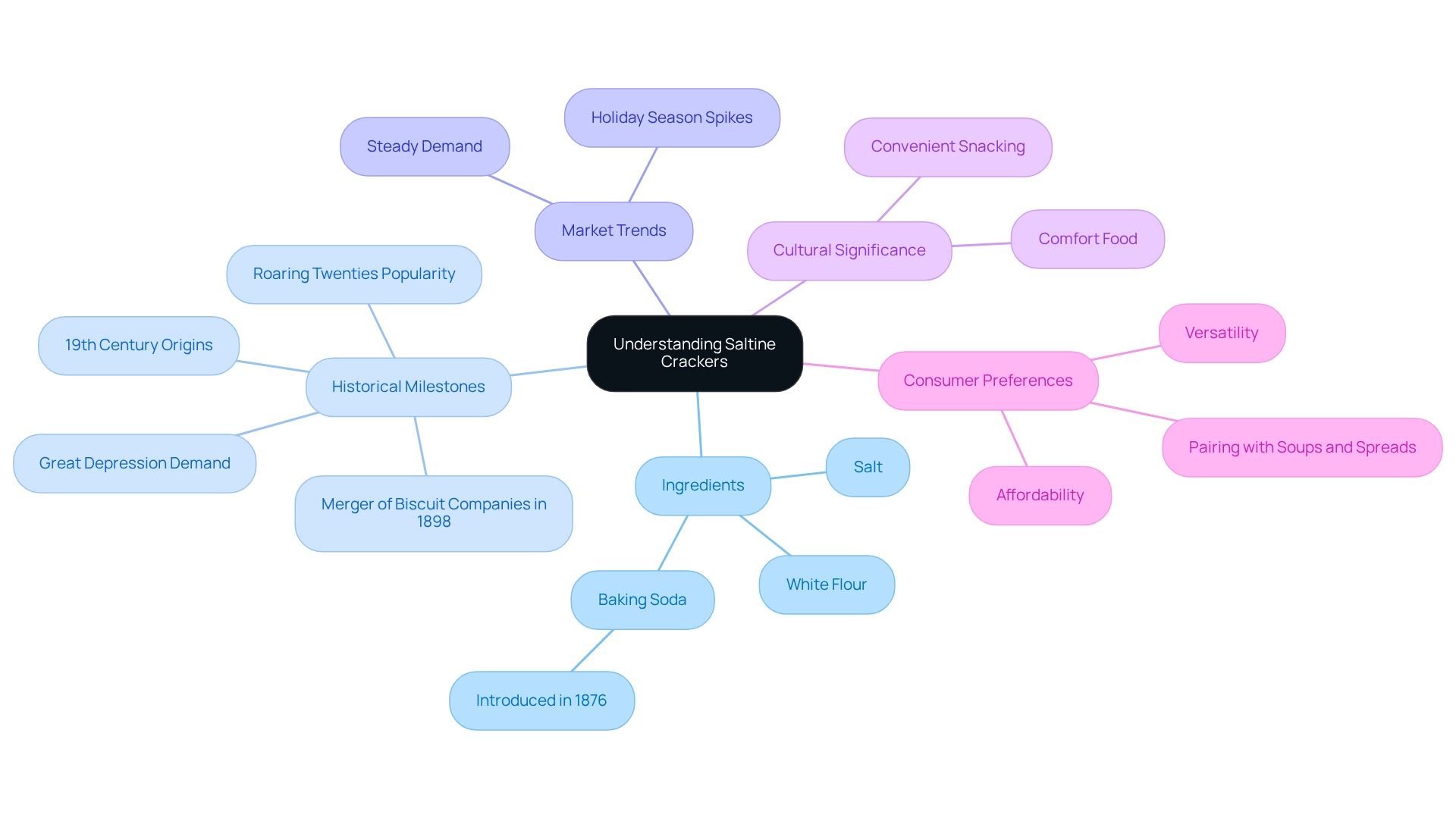
The Taste Test Methodology: How We Evaluated the Brands
To evaluate the different types of saltines, an extensive blind taste test was conducted with a diverse group of participants. Each participant tested various products without knowledge of their identities, effectively removing bias and ensuring an unbiased assessment. The crackers were rated based on several critical criteria: texture, flavor, saltiness, and overall satisfaction.
This structured method not only provided a clear ranking of the labels but also ensured that the assessment was both impartial and comprehensive. Conducted on December 10, 2020, this activity adds context to the relevance of the findings.
Experts in food science emphasize the significance of blind taste testing as a reliable methodology for food reviews. According to researchers, “We reject H₀ because 0.0002 is less than α = 0.10. We have convincing evidence that the proportion of Temple City High School students who can determine the difference between red & green gummy bears is less than 0.70.”
This underscores the importance of eliminating preconceived notions about identity, enabling a more precise evaluation of preferences. Participants were encouraged to focus solely on their sensory experiences, which is crucial for evaluating snack textures and flavors.
The criteria for ranking the saltiest saltine cracker brands were meticulously defined. Texture was assessed for its crispness and mouthfeel, while flavor evaluations focused on the balance of saltiness compared to the saltiest saltine crackers and overall taste. Participants also provided feedback on their overall satisfaction, which was pivotal in determining the top contenders.
Case studies on blind taste testing methodologies reveal that such evaluations can significantly affect buyer choices. For example, a study emphasized how blind taste tests resulted in a change in buyer preferences for snack foods, demonstrating the power of impartial assessments in influencing market trends. The statistics from these methodologies indicate that buyers often prefer products they might not have selected based on brand recognition alone.
Furthermore, students ought to assess if the findings can be applied to all individuals, which is pertinent when discussing the wider implications of the taste test results.
In summary, the impact of blind taste tests on buyer choices is profound, as they provide insights that help shoppers make informed decisions based on actual product performance rather than marketing claims. This thorough method of assessing snack biscuits guarantees that the ultimate rankings represent authentic buyer preferences.

Ranking the Brands: Results of the Saltine Taste Test
The outcomes of the recent taste test displayed a distinct ranking among the top saltine products, indicating consumer preferences for flavor and texture:
- Publix Original Saltines – This brand emerged as the top choice, celebrated for its ideal balance of saltiness and satisfying crunch. This combination makes it a favorite among snack enthusiasts.
- Market Pantry Saltines – Known for their buttery flavor and robust texture, these crackers garnered praise for their ability to complement a variety of toppings, enhancing their appeal.
- Savoritz Original Saltine Crackers – Testers appreciated their satisfying crunch and mild flavor, which made them a versatile option for both snacking and pairing with soups.
- Nabisco Premium Saltine Crackers – A classic in the market, while some buyers found them slightly less flavorful compared to competitors, they still maintained a loyal following due to their consistent quality.
- Zesta Saltine Crackers – This brand received mixed feedback; some testers enjoyed the texture, while others felt the flavor was lacking, highlighting the subjective nature of snack preferences.
These rankings not only illustrate the standout brands in terms of taste and texture but also reflect broader consumer trends in the snack food industry. Snack biscuits are favored by diverse groups, including children, adults, and seniors, suggesting their broad attraction. The worldwide salt snack market is expected to witness notable expansion, with revenue predictions indicating a rise from $252.816 million in 2021 to $490.427 million by 2033. This growth underscores the significance of these rankings within the changing market environment. Moreover, the African saltine cracker market is anticipated to expand at a CAGR of 5.276%, with South Africa being the largest market, exhibiting competitive dynamics that companies must navigate. As Nisha Deore, a Research Analyst at Cognitive Market Research, observes, understanding consumer preferences is essential for companies seeking to gain loyalty and adjust to evolving tastes. As the market evolves, these insights will be essential for companies aiming to succeed in a competitive environment.
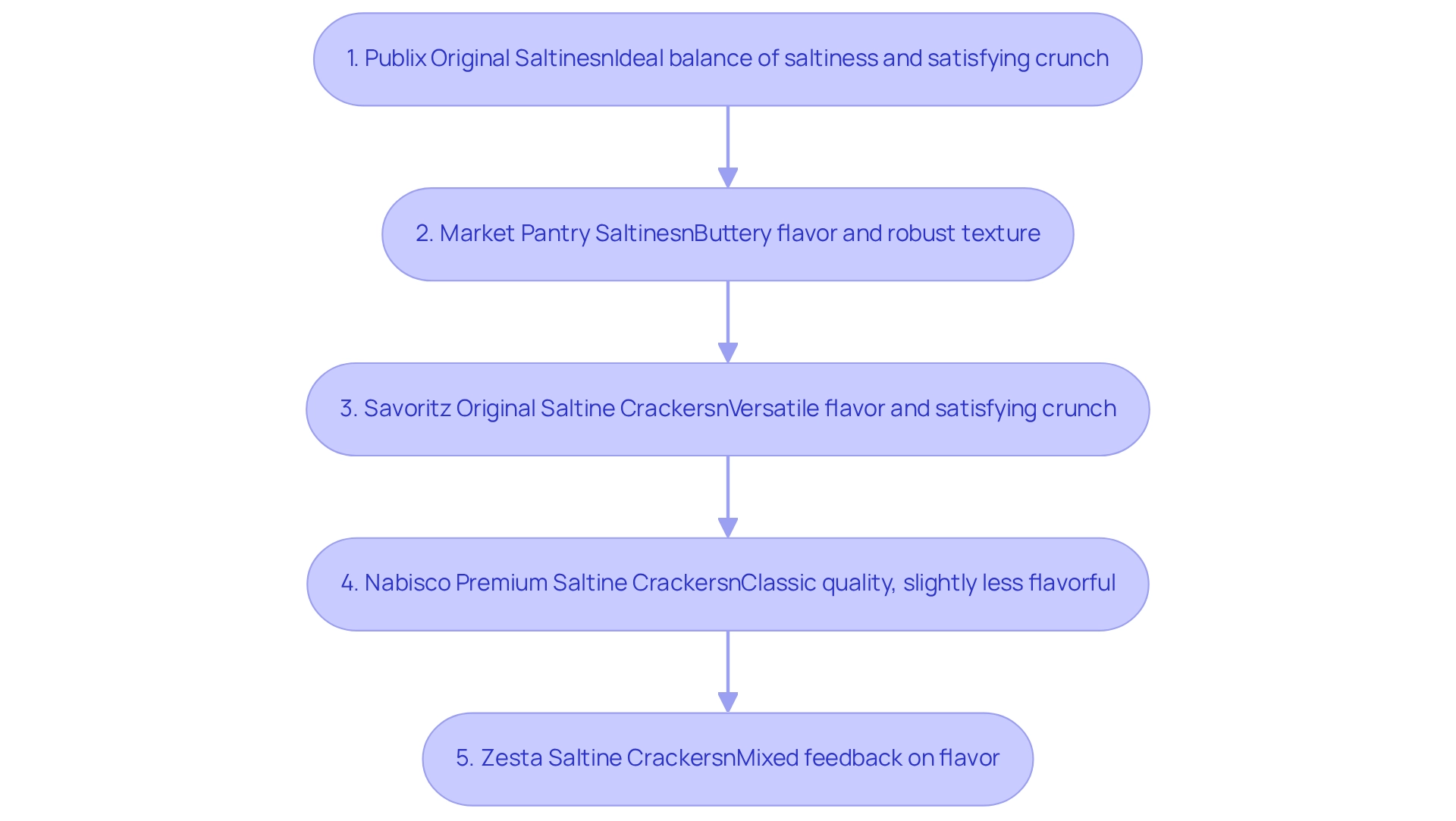
Brand Profiles: A Closer Look at Each Saltine Cracker
- Publix Original Saltines: Renowned for their exceptional crunch and well-balanced saltiness, Publix Original Saltines have garnered a loyal following among taste testers. Their versatility shines through as they pair seamlessly with soups and spreads, making them an essential pantry staple for many households. While saltine biscuits do not provide much nutrition, combining them with nut butter, dairy, legumes, meat, fish, or poultry can result in nutritious snacks, according to Amber Charles Alexis, MSPH, RDN.
- Market Pantry Saltines: This store brand stands out with its buttery flavor, which has been well-received by testers. The sturdy construction of Market Pantry Saltines makes them particularly suitable for dipping and spreading, enhancing their appeal as a snack option. These snacks fall within the calorie range of 418 to 437 calories per 100 grams, depending on the variety.
- Savoritz Original Saltine Crackers: Savoritz crackers are celebrated for their satisfying crunch and mild flavor, making them an excellent choice for snacking or as a complement to meals. Their balanced taste allows them to fit into various culinary contexts, from casual snacking to more formal dining. Pairing Savoritz with nutrient-rich foods can enhance their nutritional profile, just like other products.
- Nabisco Premium Saltine Crackers: As a classic brand in the cracker market, Nabisco Premium Saltines are widely recognized. However, recent reviews have highlighted mixed opinions regarding their flavor and texture, suggesting that while they remain a staple, they may not meet the evolving preferences of all consumers. Their calorie count is also within the standard range for saltines, making them a comparable option.
- Zesta Saltine Crackers: Zesta crackers have received a mixed reception; while some testers appreciate their texture, others find them lacking in the robust flavor profile that characterizes other brands. This divergence in opinion positions Zesta as a less favorable option for those seeking a more flavorful snacking experience. To enhance their nutritional value, individuals might consider pairing Zesta with protein-rich foods, as indicated in the case study ‘Pairing Saltine Crackers for Nutritional Balance.’
Overall, Top5.com serves as a trusted resource for consumers seeking reliable information on these products, helping them make informed choices in the saturated snack market. By considering ethical consumerism in their snack choices, shoppers can align their purchases with their values, similar to the method adopted by companies like Florence by Mills.
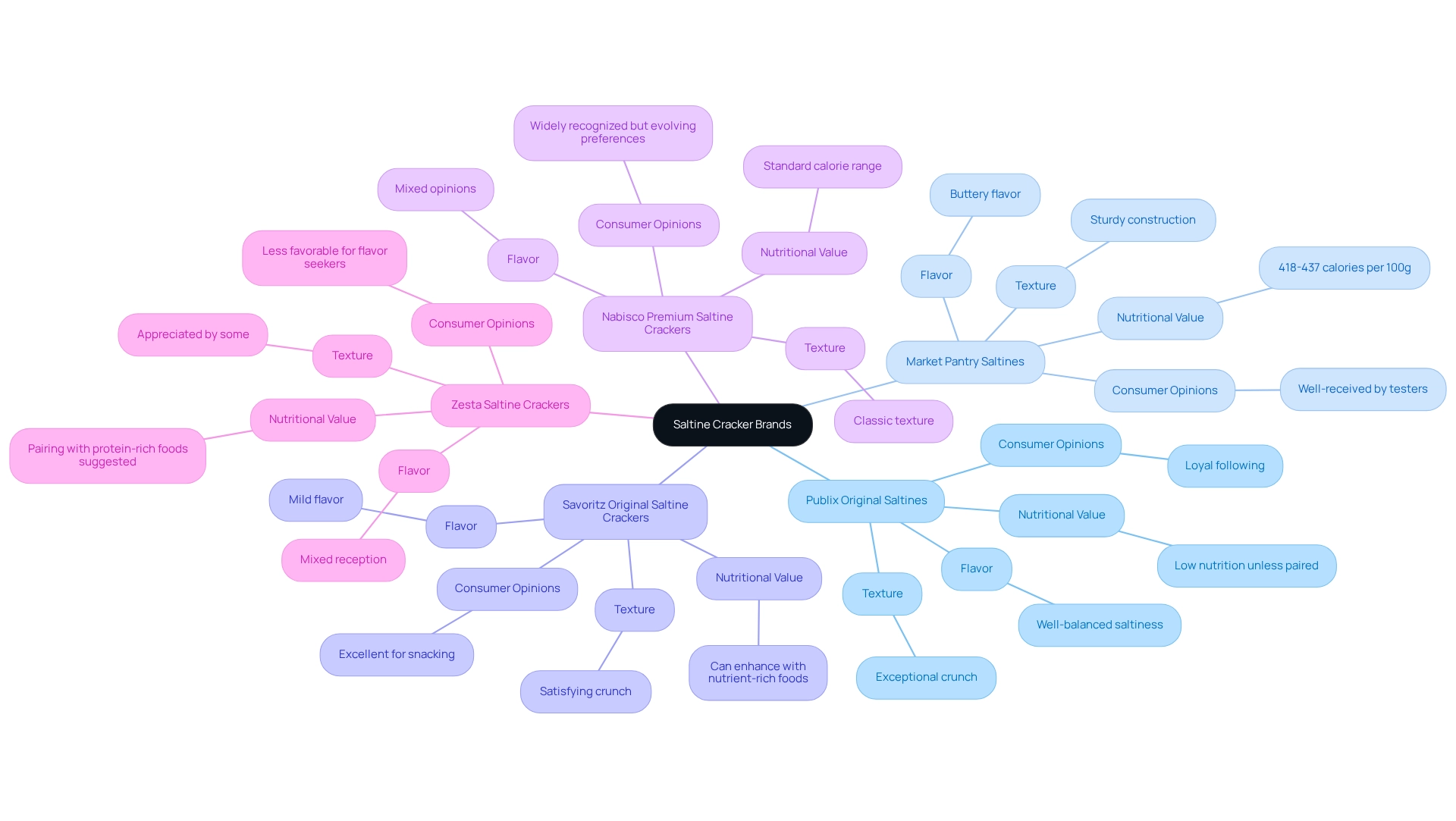
Nutritional Breakdown: Comparing Health Aspects of Saltines
In the quest to identify the saltiest saltine biscuits, a detailed examination of the nutritional content across leading labels reveals several important factors.
Calories: Most saltine biscuit labels typically contain between 60 to 70 calories per serving, which consists of five biscuits. This calorie range is consistent across various options, making them a relatively low-calorie snack choice.
Sodium: Sodium content is a critical differentiator among products. For instance, Nabisco Premium Saltines, often considered the saltiest saltine crackers, are known for their higher sodium levels, containing approximately 135 mg per serving. In contrast, products such as Market Pantry provide lower sodium options, catering to health-aware individuals who are mindful of their sodium intake.
Fat and Fiber: Saltine crackers typically have low fat levels, ranging from 0 to 1 gram per serving, and they contain less than 1 gram of fiber. While conventional saltines do not greatly enhance fiber consumption, whole grain types may offer a small boost in fiber content, attracting individuals looking for healthier snack choices. Given the growing awareness of sodium’s effect on health, especially among individuals tracking their intake, these nutritional factors are crucial considerations when choosing a product.
Recent feedback from customers highlights a growing trend in dissatisfaction with sodium levels, with some reviewers suggesting that the saltiest saltine crackers could improve the flavor. Additionally, a long-time customer of Premium Saltines expressed disappointment over a perceived change in the recipe, indicating a shift in taste that has not met their expectations. This feedback highlights the significance of transparency in ingredient sourcing and recipe consistency for companies striving to uphold customer loyalty.
A user rated the Premium Saltines 2 out of 5 stars, indicating a considerable degree of dissatisfaction. Another customer indicated that their last three purchases of Premium Original Saltine Crackers were stale, raising quality issues that could influence public perceptions of the brand. As individuals progressively emphasize health in their snack selections, comprehending the nutritional characteristics of these baked goods can enable them to make informed choices that correspond with their dietary requirements.
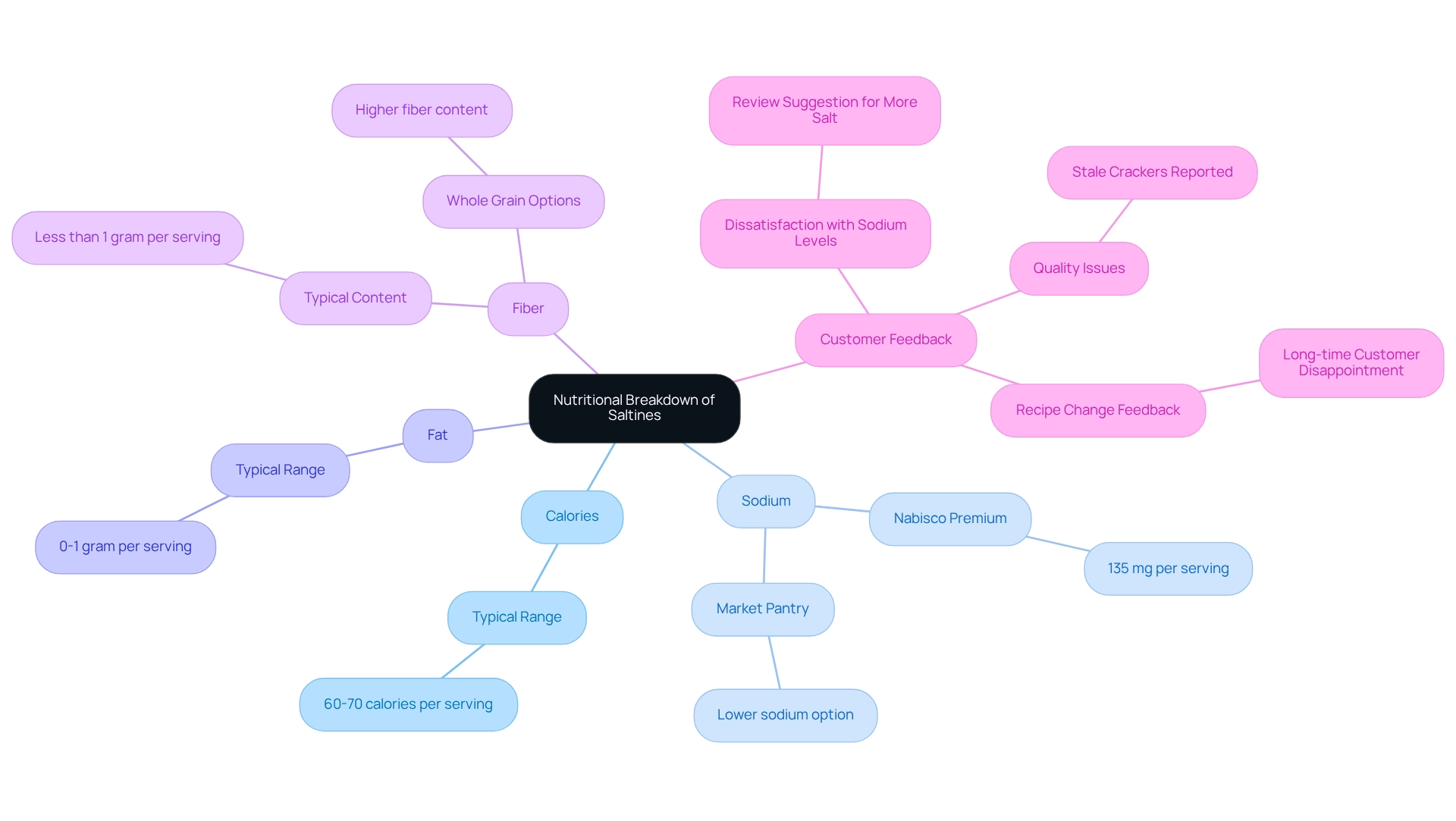
Consumer Feedback: What Shoppers Are Saying About Saltines
Consumer feedback on saltine crackers in 2025 showcases a variety of opinions that reflect individual preferences.
Publix Original Saltines: Celebrated for their taste and texture, many consumers regard them as the ideal companion for soups and snacks. Their consistent quality is often cited as a significant advantage.
Market Pantry Saltines: Shoppers praise the buttery taste and durability of these snacks. Their exceptional value for money makes them a favored option among budget-minded buyers, appealing directly to those looking for quality at a reasonable price.
Savoritz Original Saltine Crackers: Generally well-received, these crackers are appreciated for their satisfying crunchiness and mild flavor. They particularly appeal to those who prefer a lighter snack, highlighting the variety in consumer tastes.
Nabisco Premium Saltine Crackers: While a loyal group of customers continues to support this brand, some individuals have expressed disappointment regarding recent quality changes. This indicates a shift in satisfaction levels, prompting a reevaluation of their place in the market.
Zesta Saltine Crackers: Opinions about this product vary; some appreciate the texture, while others feel it lacks adequate flavor. This divergence underscores the diverse preferences among individuals.
These insights emphasize the importance of individual preference in choosing a favored brand, showcasing the varied landscape of buyer tastes in the snack market. With a U.S. population estimate of 341.96 million for 2024, the potential market for crisp biscuits is substantial. As Vishakha Agrawal from Expert Market Research observes, “At Expert Market Research, we strive to provide you with the most recent insights and trends in the market,” implying that understanding buyer preferences is essential in this expanding sector.
The market for savory biscuits is experiencing significant growth opportunities, driven by increasing demand for health-conscious and sustainable products. Additionally, a competitive landscape analysis reveals that major players are focusing on product innovation and geographic expansion to strengthen their market positions, further influencing consumer choices.
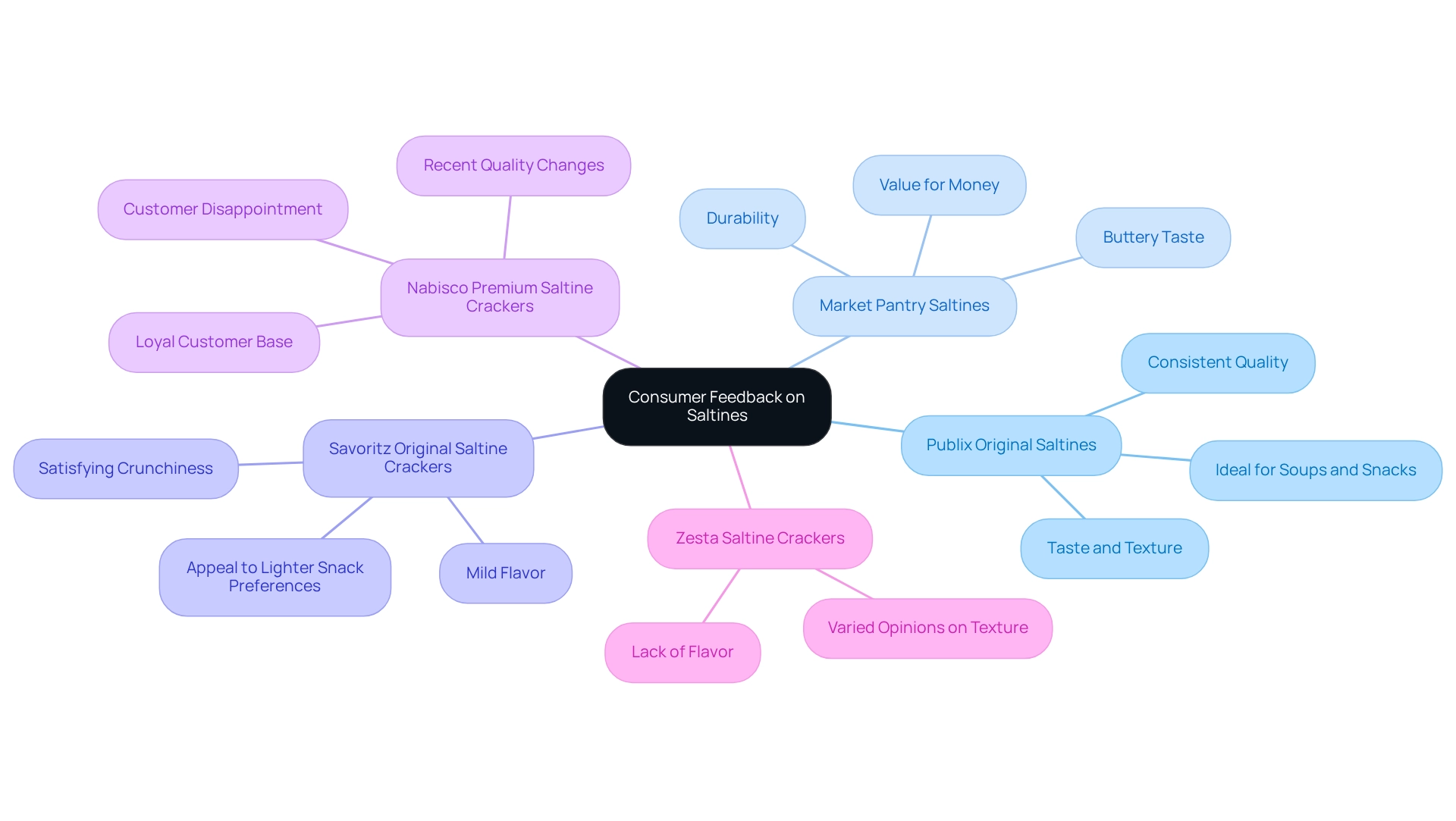
Final Thoughts: Choosing the Best Saltine Cracker for You
Selecting the ideal saltine cracker, particularly the saltiest options, hinges on individual tastes and dietary requirements. For those prioritizing flavor and texture, Publix Original Saltines stand out as a top choice, delivering a satisfying crunch and rich taste. If budget is a key consideration, Market Pantry Saltines offer excellent value without compromising on the buttery flavor that many snackers enjoy.
Meanwhile, Nabisco Premium Saltines remain a classic favorite, though it’s important to note that quality can vary between batches.
To navigate the diverse options available, consider these best practices for selecting snack foods in 2025:
- Prioritize companies that align with your health goals, such as those offering portion-controlled snacks or those rich in vitamins and protein.
- Nutritionists often recommend choosing snacks that not only satisfy cravings but also contribute to overall well-being.
- As Trishita Deb observes, 74% of shoppers seek the flexibility to utilize any shopping channel, indicating the necessity for adaptable snack choices that accommodate different lifestyles.
Moreover, with 72% of people looking for healthier snacking options, trying out different products can assist you in identifying the ideal crisp that best fits your taste and dietary needs. Ultimately, discovering your preferred crisp may require tasting several different types of the saltiest saltine crackers. This exploration not only enhances your snacking experience but also aligns with the rising trend of making snacking more interactive and enjoyable, as brands increasingly focus on enhancing the overall user experience.
Furthermore, the recent resurgence in searches for sourdough illustrates how consumer interests are shifting in the snack market, particularly influencing choices in the saltiest saltine crackers.
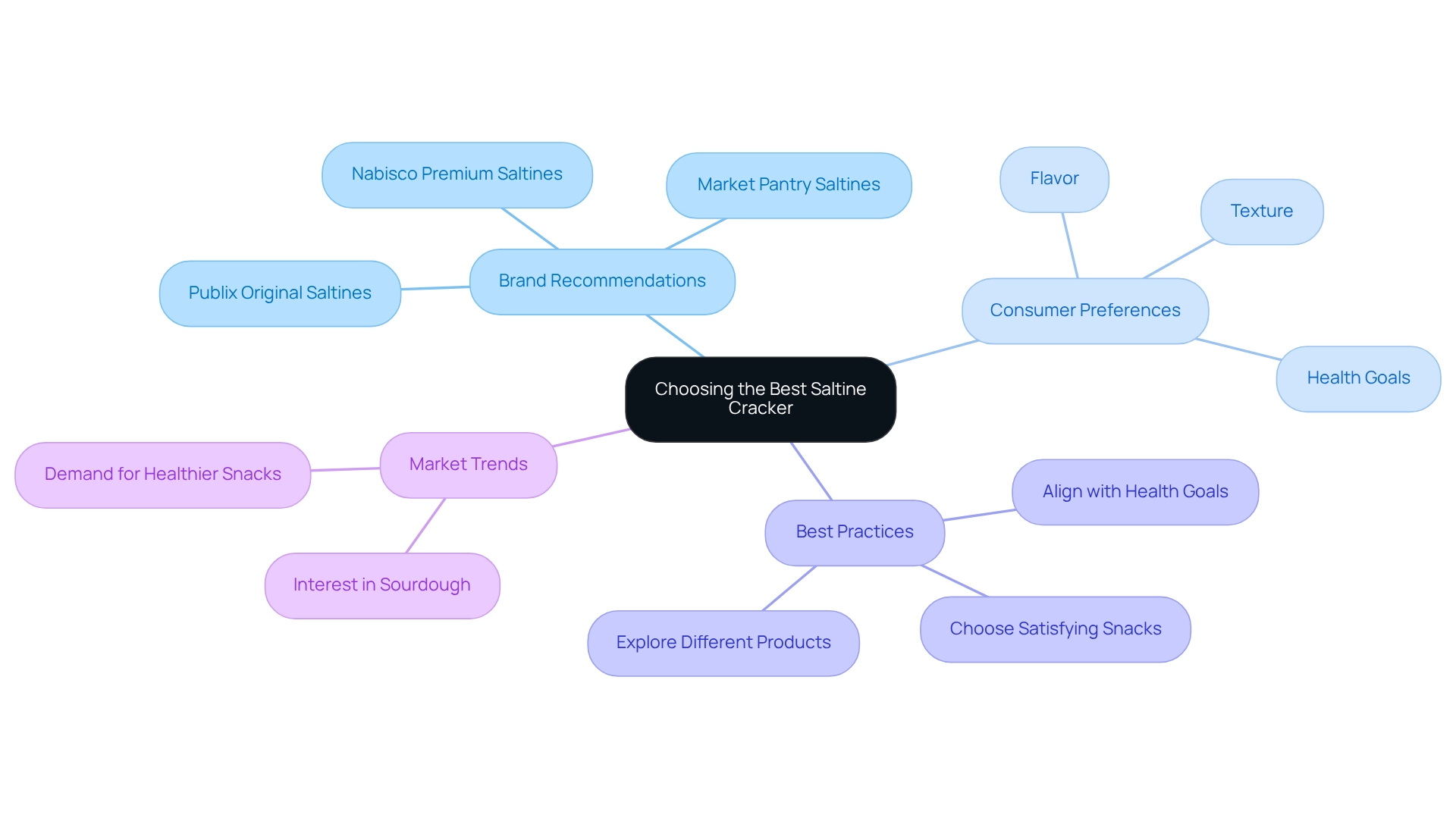
Conclusion
Saltine crackers have established themselves as a timeless staple in American households, evolving from their humble 19th-century origins to remain a beloved snack option in 2025. Their light, crispy texture and mild flavor secure their place in the pantry, often accompanying soups, cheeses, and spreads. A comprehensive taste test revealed consumer preferences that highlighted brands like Publix Original Saltines for their exceptional balance of flavors and crunch, while Market Pantry Saltines emerged as a robust choice for budget-conscious snackers.
As the snack food market continues to grow, understanding the nutritional aspects of saltines becomes crucial for health-conscious consumers. With varying sodium levels and calorie counts, brands like Market Pantry and Savoritz cater to those seeking healthier options without sacrificing taste. Consumer feedback underscores the importance of quality and consistency, particularly for established brands like Nabisco, which face scrutiny over recipe changes and product performance.
Ultimately, the journey to finding the perfect saltine cracker is shaped by individual tastes and dietary needs. With the increasing demand for quality snacks that align with health goals, exploring different brands not only enhances the snacking experience but also reflects broader trends in consumer preferences. As the market for saltine crackers continues to evolve, their enduring charm and versatility ensure that they will remain a cherished choice for many.
Frequently Asked Questions
What are saltine biscuits and what are they made of?
Saltine biscuits, also known as soda biscuits, are thin, crispy snacks primarily made from white flour, baking soda, and salt.
What is the historical significance of saltine biscuits?
Saltine biscuits originated in the 19th century and evolved significantly in 1876 with the introduction of baking soda. They became a staple during the Roaring Twenties and saw increased demand during the Great Depression as an economical food choice.
How are saltine biscuits commonly enjoyed today?
Today, saltine biscuits are popular in many households and are often enjoyed with soups, cheeses, or spreads due to their light texture and mild flavor.
What is the current market trend for saltine crackers?
As of 2025, there is steady demand for saltine crackers, especially during the holiday season, reflecting their status as a preferred snack among cost-conscious consumers.
What do food historians say about the role of saltine biscuits in American culinary history?
Food historians highlight saltine biscuits as a comfort dish and a convenient option for quick snacking, noting their lasting popularity in homes and on store shelves.
How did the development of soda biscuits evolve?
The development of soda biscuits was marked by the merger of the New York Biscuit Company and the American Biscuit and Manufacturing Company in 1898, which led to enhancements in the soda biscuit and the introduction of Premium Soda Biscuits.
What methodology was used to evaluate different types of saltine crackers?
An extensive blind taste test was conducted with participants who evaluated various products based on texture, flavor, saltiness, and overall satisfaction without knowing the identities of the brands.
Why is blind taste testing significant in food reviews?
Blind taste testing eliminates bias and preconceived notions about brand identity, allowing for a more accurate evaluation of preferences based solely on sensory experiences.
What criteria were used to rank the saltine cracker brands in the taste test?
The criteria included assessing texture for crispness and mouthfeel, flavor evaluations for the balance of saltiness, and overall satisfaction from participants.
How do blind taste tests influence buyer choices?
Blind taste tests can significantly change buyer preferences, as they provide insights that help consumers make informed decisions based on actual product performance rather than brand recognition.





